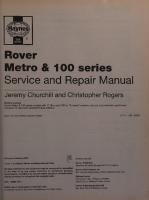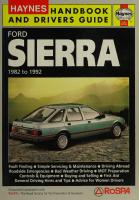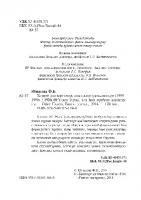Austin/MG Metro 1980 to May 1990 Handbook and Drivers Guide 1850108145, 9781850108146
“160 pages : 24 cm Covers all Austin/MG Metro models, including Vanden Plas. Does not cover revised (Rover) Metro range
150 66 11MB
English Pages 168 Year 1992
Recommend Papers
File loading please wait...
Citation preview
HAYNES NODS EIN TAW LE
METR
ea
Fault Finding @ Simple Servicing & Maintenance @ Driving Abroad
Roadside Emergencies @ Bad Weather Driving @ MOT Preparation Controls & Equipment @ Buying and Selling @ First PNTe| General Driving Hints and Tips @ Advice for Women Drivers
Produced in association with RoSPA — The Royal Society for the Prevention of Accidents
ENTPAl =
q
er
We hope you wil! enjoy this book. Stamped below wil! avoid fines a
Service.
Books
may
be renewed
ur
ku
eT
| -2paAnV ee a
a
Ye |
Digitized by the Internet Archive in 2022 with funding from Kahle/Austin Foundation
https://archive.org/details/austinmgmetro1980000chur
’
*
INUIT Le
METRO
‘1980 to May 1990
wWAll Austin/MG Metro models, including Vanden Plas. iDoes not cover revised (Rover) Metro range introduced in May 1990.
A Haynes Handbook and Drive © Haynes Printed and J H Haynes & Nr Yec
e:
was
YN |b) :(el0)
SP MCMC
eA
a?
=
5
by Jeremy Churchill Full details of all servicing and repair tasks for the models covered by this Handbook can be found in the Owners Workshop Manual - OWM 718 Austin/MG Metro.
d Sparkford i
ISBN 185010 814 5 British Library Cataloguing in record for this book Is¢ from the British Library
i
meee
book me
duced or
nitted in any formorby any ' on
in writing from
copyright holder DEFGHJKLMNOPQRST
BA22 7JJ
the
2
ACKNOWLEDGEMENTS We gratefully acknowledge the assistance of RoSPA in compiling the information used in this Handbook. Thanks are also due to Duckhams Oils who provided lubrication data and to Britax who supplied information on child safety. Certain illustrations, including the cover photography, are the copyright of the BMIHT/Rover Group and are used with their permission. Additional photographs supplied by Quadrant Picture Library/Auto
Express. Thanks are also due to all those people at Sparkford who helped in the production of this Handbook.
We take great pride in the accuracy of information given in this Handbook, but vehicle manufacturers make alterations and design changes during the production run of a particular vehicle of which they do not inform us. No liability can be accepted by the authors or publishers for loss, damage or injury caused by any errors in, or omissions from, the information given.
Metropolitan Borough of Stockport (
Libraries
0)0 0 5 2 2 5 9g U
AUSTIN/MG
METRO
About this Handbook The Metro family Buying and selling
5 7 9
General tips on buying
9
Car crime prevention Service specifications Regular checks
65 67 71
Checking oil level
72
Points to look for when buying
10
Checking coolant level
General tips on selling
11
Checking brake fluid level
74
Dimensions and weights
13
Checking clutch fluid level
75
Controls and equipment
15
Checking tyres
Ws)
Driver's instruments and controls
19
Checking washer fluid level
a7
Interior equipment
27,
Checking battery electrolyte level
77
Exterior equipment
31
Checking wipers and washers
78
33
Checking lights and horn
Accidents and emergencies How to cope with an accident
First aid
:
33
Requirements of the law
Servicing
36
jService schedule.
36
_ Safety first!
;
Essential details to record “Accident report form
To
How to cope with a fire
:
How to cope with a broken windscreen
pinectpets pat
40
Service tasks
40
Seasonal servicing
41
Breakdowns on ann ordinary road Motorway breakdowns “Changing aa wheel Towing
[
41 _
42
= bead
Starting a carr with a flat battery
Driving safety Driving inbad weather Motorway driving
:
Towing a trailer or caravan
Alcoholanddriving
Bracontall .
Advice to women drivers
“Child Sactya 2
ee
METRO
a
Care of your tools
ik 2
‘50
Relays
113 1 13
E j 4 13 114
Bulbs — exterior lights
Fuses
411
: vad
Bulb, fuse and relay renewal Bulbs - interior lights ,
5?
*
Bodywork and interior care
49
SD
109
111
"What to bbuy
Dealing with scratches
‘54
te
Tools
Cleaning: the bodywork
Driving Abroad ‘59 Reducing the costof‘motoring 63 AUSTIN/MG
; 89 :x
46
51
86
ae
45
352
ae
82 .
Cleaning the interior
49
Before starting a journey 7
;
42
What to carry in case of a breakdown 47
«79 gt
37
What to do if your car isbroken into 40
Breakdowns
79
Checking forfluidleaks
34
.
Ve
115 116
;
119 121
.
122
Preparing forthe MOT test Fault finding Car jargon Local radio frequencies Conversion factors
123 125 131 141 146
Distance tables
148
Index
150
ABOUT THIS HANDBOOK
pe os geet
ri
ea ta Ree elves
ee oe
a Se
.
nal Aik. i.
ae OHy oe 2aacendigitaa
tor
SSS,
nbs eres Ee.
ts aN
AUSTIN/MG
METRO
|
ABOUT THIS HANDBOOK
The idea behind this Handbook is to help you to get the most out of your motoring. Apart from the things that every owner needs to know, to deal with unexpected mishaps like a puncture or a blown light bulb, you'll find clearly presented information on road safety, hints on driving abroad, and tips on how to prepare your car for the MOT test. We've also included details of local radio frequencies to help you avoid those inevitable ‘jams’, and there’s a section on what to do in the unfortunate event of an accident. For those not familiar with their car, there's a Section to explain the location and the operation of the various controls and instruments. Additionally, there’s a Section on fault finding, and a useful glossary of car jargon. Garage labour charges usually form the major part of any car servicing bill, and we hope to help you to reduce those bills by carrying out the more straightforward routine servicing jobs yourself. If you're about to start carrying out your own servicing for the first time, we aim to provide you with easy-to-follow instructions, enabling you to carry out the simpler tasks which perhaps you've left to a garage or a ‘car-minded’ friend in the past. Even if you prefer to leave regular servicing to a suitably qualified expert, by using this book you'll be able to carry out regular checks on your car to make sure that your motoring is safe and hopefully trouble-free. You'll also find advice on buying suitable tools, and safety in the home workshop. Some readers of this Handbook may not yet have bought a Metro, so we've included a brief history of the range, and some useful tips on buying and selling. All in all, we hope that this book will prove a handy companion for your motoring adventures, and hopefully we'll help to reduce the problems which inevitably crop up in everyday driving. If you’re bitten by the DIY bug, and you're keen to tackle some of the more advanced repair jobs on your car, then you'll need our Metro Owners Workshop Manual (OWM 718). This manual gives a step-by-step guide to all the repair and overhaul tasks, with plenty of illustrations to make things even clearer. Happy motoring!
LA SIK MOO . BUSTIN/ MG
METRO
THE METRO FAMILY
AAAS
M&K,
A Metro 1.0 L (1986)
AUSTIN/MG.
METRO
|
THE METRO FAMILY
The first thing to clarify when contemplating the Metro originally launched as the ‘Austin miniMetro’ (with the name). However the name rapidly became abbreviated, to ‘Metro’. This was officially recognised by the factory
family is its name! The car was Vans briefly using the ‘Morris’ by both the factory and public, from 1983 onwards by
renaming the car ‘Austin (or MG) Metro’.
In the meanwhile, the factory itself was undergoing several changes of name; known as BL Cars Ltd at the time of the Metro's launch, it became the Austin Rover Group Ltd during 1982/3 and finally, during 1989, the Rover Group Ltd. Authorised dealers can therefore have operated under the ‘Austin Morris’, ‘British Leyland’, ‘Austin Rover’ or ‘Rover’ flags during the life of the Metro. Obviously, this confusion of names for what was evidently the same car meant that the factory name became meaningless to the public, and in fact later cars have only ‘Metro’ badges, all external references to the maker having been deleted. Launched in October 1980, the first Metro models were available only in 3-door Hatchback bodystyle, with 1.0 & 1.3 engines and a 4-speed manual gearbox. A model with a 1.3 engine and 4-speed automatic transmission followed in 1981, with MG Metro and MG Metro Turbo models appearing in 1982, and 5-door Hatchback models in 1984. In October 1984, the whole range was facelifted, with a new bonnet, radiator grille and grey plastic one-piece bumpers. Significant improvements in build quality were made at the same time; in particular, all models built from this date are much more resistant to rust. All the engines are of 4-cylinder in-line layout, mounted transversely at the front of the car, with the gearbox/transmission bolted underneath the engine. Although based on components from the famous Mini, the engine and gearbox/transmission were heavily revised, to improve durability and reduce noise, to reduce servicing time, and to improve fuel economy. The suspension is by the Hydragas system, being fully independent at the front, and linked from side to side at the rear. Both the suspension and the (rack-and-pinion) steering components are located on separate subframes that are rubber-mounted to the body. Braking is by discs (with 4-piston calipers) at the front, and drums at the rear, operated by a dual-circuit hydraulic system. Trim levels varied from the basic model, through L (or City) levels up to the wellappointed HLE/HLS standard (later replaced by the Vanden Plas, Mayfair and GS models).
A Metro GTa (1989)
AUSTIN/MG
METRO
OL sHL
THE METRO FAMILY
A MG Metro Turbo (1986)
—
beeen
sige
| fae
Mey frre \
ee
A Metro Mayfair 1.3 (1986)
AUSTIN/MG
METRO
|
BUYING AND SELLING
Ss Ww INSPECTED
‘
¢
GENERAL TIPS ON BUYING @ @ @ @
Don’t rush out and buy the first car to catch your attention Always buy from a recognised dealer in preference to buying privately Have the car checked over by someone knowledgeable before you buy it In general, you get what you pay for!
Before buying a second-hand car, it’s worthwhile doing some homework to try and avoid some of the pitfalls waiting for the unwary. First of all, don’t rush out and.buy the first car to catch your attention (all that glitters is not gold!), and remember that much of the responsibility is yours when it comes to the soundness of the deal, especially when buying a car privately. Wherever possible, buy from a recognised dealer, and check that the dealer is a member of the Retail Motor Industry Federation, as this will provide you with certain legal safeguards if you have any problems. If you buy from a dealer, you are covered by the Sale Of Goods Act, which in summary states that the goods must be fit for their intended purpose, the goods must be of proper quality, and the goods must be as described by the seller. If you're buying a car privately, ask to see the service receipts and the MOT certificates going back as long as the car has been in the possession of the current owner (this will help to establish that the car hasn’t been stolen, and that
the recorded mileage is genuine), and always ask to view the car at the seller's private address (to make sure that the car isn’t being sold by an unscrupulous dealer posing as a private seller). Check the vehicle documents for obvious signs of forgery and, if in doubt, contact the DVLA and give them details of the Registration Document, as they will be able to run a check on its authenticity. As far as the soundness of the car itself is concerned, a genuine service history is helpful. This is provided by the service book supplied with the car when new, which should be completed and officially stamped by an authorised garage after each service. Cars with a full service history (fsh) usually command a higher price than those without. To check the condition of a car, a professional examination is well worthwhile, if you
can afford it, and organisations such as the AA and RAC will be able to provide such a
service. Otherwise, you must trust your own judgement, and/or that of a
AUSTIN MG
METRO
NIT 8ONI.
10
Brera knowledgeable friend. Although it’s tempting, try not to overlook the mechanical soundness of the car in favour of the overall appearance. It’s relatively easy to clean and polish a car every week, but when were the brakes and tyres last checked? Above all, safety must always take priority. Don’t view a car in the wet, as water on the bodywork can give a
misleading impression of the condition of the paintwork. First of all, check around the outside of the car for rust, and for obvious signs of new or mis-matched paintwork which might show that the car has been involved in an accident. Check the tyres for signs of unusual wear or damage, and check that the car ‘sits’ evenly on its suspension, with all four corners at a similar height. Open the bonnet and check for any obvious signs of fluid leakage (oil, water, brake fluid), then start the engine and listen for any unusual noises — some background noise is to be expected on older cars, but there should be no sinister rattles or bangs! Also listen to the exhaust to make sure that it isn’t ‘blowing’ indicating the need for renewal, and check for signs of excessive exhaust smoke. Black smoke may be caused by poorly adjusted fuel mixture, which can usually be rectified fairly easily, but blue smoke usually indicates worn engine components, which may prove expensive to repair. Finally, drive the car, and test the brakes, steering and gearbox. Make sure that the car doesn’t pull to one side, and check that the steering feels positive and that the gears can be selected satisfactorily without undue harshness or noise. Listen for any unusual noises or vibration, and keep an eye on the instruments and warning lights to make sure that they are working and indicating correctly. If all proves satisfactory, try to negotiate a suitable deal, but remember that a dealer has to work to a profit margin, and it's unlikely that you'll find a good car for a silly price. Always obtain a receipt for your money. On the whole, it’s true to say that you get what you pay for. Above all, don’t be rushed into making a hasty decision.
POINTS TO LOOK FOR WHEN BUYING A METRO Cars built from October 1984 onwards are an improvement on earlier models, and will prove a better buy; if a lot of long journeys are envisaged, choose a 1987-on model, which will have improved sound insulation. Remember that the MG, Sport and GTa models offer performance increases at the cost of higher insurance groupings (and reportedly limited gearbox life). Do not be over-impressed by the limited edition models (eg ‘Gala’, ‘Moritz’) — these are merely standard models with special paintwork and trim; check other Metros of the same year, to ensure that you are not being asked to pay over the odds for a tarted-up standard model! There is in fact good reason to avoid these limited editions altogether, because of the potential extra cost of repairing special paintwork. The MG Metro Turbo is best avoided; it can be troublesome, and there is some doubt about the longevity of the gearbox. Corrosion Is not usually a problem on Metros; check for surface rust due to neglected stone chips on the bonnet, the front valance (the ‘chin’ panel beneath the front
bumper/numberplate), the sill panels (under the doors) and around the wheel arches.
AUSTIN/MG
METRO
7
BUYING AND SELLING
Damage such as this, where found, can be
used to reduce the asking price. On early models, there are a few areas which are rust-prone. Check carefully the front valance, the front wings and the bottom edges of the doors and tailgate; bubbling paintwork or small rust holes in these areas can be used either to reduce the asking price or to reject the car, depending on the damage and your ability to deal with it. The front wings are bolted on, and can be renewed relatively cheaply — don’t be afraid to ring a body repair specialist for quotes, and to use these as bargaining counters. However, check very carefully at the base of the windscreen pillars and along the sills — get down on your hands and knees, and (carefully!) run your hand along the floorpan behind each sill panel to check for holes or flaking metal; if rust is evident, reject the car. If significant rusting is found on an October 1984-on model, this is unusual enough to indicate a serious problem that warrants
outright rejection of the car, however cheap it may appear. Check for signs of water leaks around the windscreen and from the bottoms of the (front) doors; some early models were prone to leakage here, so check that the carpets are not rotted or the floorpan rusted.
GENERAL TIPS ON SELLING @ Make sure that the car is clean and tidy @ Make sure that all of the service documents, registration document etc, are available for inspection @ Ask yourself ... ‘Would | buy this car?’
The engine/transmission is reliable, but can
be noisy from new; if possible, take along someone who knows Metros, and who can distinguish any unusual noises from the usual rattles and whines. When you road test the car,
accelerate hard to about 25 mph using first and second gears, to check that you can change gear without crunching, then check that gearchanges can be made without undue stickiness, and without wrestling with the lever.
If any doubt exists about the condition of the gearbox, reject the car. lf the car seems to be sitting unusually low or high at either end, the ride heights will need checking; they can only be reset by a dealer (usually only Rover dealers have the necessary equipment), but this is not expensive.
mos
TING
METRO
Obviously when selling a car, bear in mind the points which the prospective buyer should be looking for, as described in the above sections. It goes without saying that the car should be clean and tidy, as first impressions are important. Any fluid leaks should be cured, and there's no point in trying to disguise any major bodywork or mechanical problems. If you're trading the car in with a dealer, you will always get a lower price than if you sell privately, but you can be fairly sure that there will be less comeback to you should any unexpected problems develop. If selling privately, don’t allow the buyer to take the car away until you have his/her money, and it’s a good idea to ask him/her to sign a piece of paper to say that he/she is happy to buy the car as viewed, just in case any problems develop later on. Give a receipt for the money paid.
1
12
Mate
Gem Taichi
(rerry Dave:
HAYNES
AUSTIN/MGUMET
RO
DIMENSIONS AND WEIGHTS
wateide
Note: All figures are approximate, and will vary depending on model
DIMENSIONS
[mm (in)]
Overall length
;
All models.
i
3405
(134.2)
Overall width All models — including door mirrors
n
1730 (68.2),
Overall height All models — at kerb weight and correct ride heights
1360 to 1378 (53.6 to 54.3)
WEIGHTS [kg (Ib)] Nominal
kerb weight - unladen, but with full fuel tank
Van models
740 to 760 (1632 to 1676)
MG Metro Turbo
840 to 847 (1852 to 1868)
All other 3-door manual gearbox models
735 to 829 (1621 to 1828)
3-door automatic transmission models
804 to 855 (1773 to 1885)
5-door manual gearbox models
798 to 838 (1760 to 1848)
5-door automatic transmission models
820 to 864 (1808 to 1905)
Maximum
roof rack load
All models
Maximum
48 (106)
towing weight (for trailer or caravan)
1980 to 1981 models:
1.0 litre models
406 (895)
1.3 litre models
575 (1268)
1982-on models:
#0.HLE
720 (1588)
All other 1.0 litre models
850 (1874)
1.3 HLE, automatic transmission models All other 1.3 litre models
Maximum
650
(1433)
950 (2095)
trailer/caravan noseweight 45 to 55 (99 to 121)
All models
AUSTIN/MG
METRO
SLA 8SNO
14.
CONTROLS AND EQUIPMENT
AUSTIN/MG
METRO
|
CONTROLS AND EQUIPMENT
15
For those not familiar with Metro models, this Section will help to identify the instruments and controls. Typical instrument panel layouts are shown in the accompanying illustrations. The operation of most equipment is selfexplanatory, but some items require further explanation to ensure that their use is fully understood. Note that not all items are fitted to all models.
16
17
18
19
9
64
5
H27095
A Typical control layout for models up to October 1984
Side window demist vents Ashtray Headlamp dip/flash, horn and direction indicator switch 4 Bonnet release handle 5 Rear window wash/wipe switch 6 Rear foglamp switch 7 Instrument pane! 8 Warning lamp panel 9 Hazard warning switch 10 Windscreen wash/wipe and headlamp
1. 2. 3
11 12 13 14 15 16 17 18 19
Glovebox release button Heater/air distribution controls Radio/cassette player controls Face level ventilation vents Cigar lighter Choke control Lighting switch Ignition switch/steering lock Heated rear window switch
washer switch
LNS SIO 8 AUSTIN/MG
METRO
16
CONTROLS AND EQUIPMENT
)
H27096
6
7
2
4
3
1
A Instrument panel layout - Metro, LE, City, CityXand Van up to October 1984, L up to October 1983
1 2 3 4
Speedometer Total mileage recorder Trip mileage meter Trip meter reset button
5 6 7
Fuel gauge Temperature gauge Warning lamp panel
/
LS
ah
1
/~10
-9 8 CT,
5
Leeds
: 109 174
192
Hull
124
Leicester
Lincoln
362
169 158
Liverpool
119 230 568 457 48 64 325 360 BN 412 774 663 203 206 518 262 198 224 626 515 354 241 299 637 156 512 401 167 64 262 473
164 103
Manchester_
132 Ss 190 257 74 158 123 402 291 272 217 143 256 139 97 126 597 560 353 481 389 318 250 (486 447 343 652 312 229 280 281 284 412 320 249 181 7B 113 371 302 112 345 50128 115 31 30 126 220 104 169 348 278 70 135 36 65 45 74 40 128 150 40 64 394 256 575 235 140 191 222 202 322 186 163 66 222 153 233 201 264 259 224 317 289 225 224 163 396 294 365 575 506 194 254 269 542, 229 175 211 168 183 321 273 176 143 271 202 200 209 68 119 105 102 255 oh analb 59 246 177 126 101 169 464 137 83 181 401 332 78 56 ag 343, (24 108 77 98 64 79 182 AUSTIN/MG
615
BEL 243 58 264 480 266
417 338 336 (172 586 426 549 901 790 288 378 669 383 385 389 595 446 333 224 17968 428 399 179 394 257 304 525 533 338 a5) 550 439 322 344 372 623 520 518 414 795 631 742 1083 972 470 566 837 612 447 547 900 789 290 386 668 439 340 338 230 245 402 354 478 101 241 216 568 457 425 306 241 335 151 198 418 481277 325 639 528 201 262 455 61 196 151 190 240 148 262 663 552 180 103 412 673 605 604 ‘428 842 682 816 1159 1049 555 634 925 108 119 64 148 277 116 272 613 502 90 58 378 138 301 Ore 119 480 369 206 105 225 82 245 169 56 201 562 451 185 72 Me 253 360 167 251 ‘563 452 50 119 357 1
375 40 86 266 92 187 152157 523 174 116 105 224 104 424 i226 156 163 507 169 74 125 412 720° 381 298 349 350
94 118 149 92
90
747
106 587 357 925 246 814 375 Bien 323, 490
679
4
283 293 Norwich 122 134 Nottingham
95 291 Oxford
396 285
160 398 120 320 225
645
Penzance
534
Plymouth
90
Sheffield
203 126 Preston 163
193° 398 | 515
422
247
378 127 Newcastle
362
Southampton Stranraer
161 418 Swansea 257 Worcester_
) 160
York
10 e UL ae A
C
/NOUP ATS IMEMISO S,.cnneis se aoneonecounesecpotecoanncene: 5 AGCICENILS Acute enero aero eee aes 33 DSalInGWiNticosaenccmasesa dire hexane aad et39 IFS talc ah metarncinattemntma tite ttaesaetna hee ete34 RECON GIG lal SO lneaemeavaene trent naanteat 36 Requirements of the laW .............0ceceeeeees 36 Air cleaner element, renewal ...........000000cc008 98 NICOLA ACUGIVALIG) contencercte tecnaviene cases sktoneecast 54 Alternator drivebelt, checking............. LOS OY Asbestos, precautions concerning................. 87
Cafaval, COW IM Ooacaae steerer neeeer aaerner eeneeneeme 50 Gar DUretlOne. .temnuser neta eee eee 96, 100 Central door locking syste ............::00eeees 31 Changing a wheels 5.05: i vaseueecteceeceteerraene 42 Child Satety ss cco /edeavieaccerpncas some annem 57 CHOK GE cccerere trot ete rns ence nea eee Lz Cigar ViGhteas.tcs testes tet eee ee ee 27, CHOCK pis < dete oalistan stidensaocad Uectes a 20 CINE cari cea aieeleta Ree Sse ae eee 106 Clutch: tuted level Zs, cid. chbenstaa ements te tmes is CONMPULGI2..r cana eter seer athe ener ee 20 Controls and equipment..................cc0000eeeeees 15 COPVETSIONITACIOlS
![Haynes Austin MG Metro 1980 to 1990 Owners Workshop Manual [1]
1850108110, 9781850108115](https://ebin.pub/img/200x200/haynes-austin-mg-metro-1980-to-1990-owners-workshop-manual-1-1850108110-9781850108115.jpg)
![Metro Ethernet: the definitive guide to enterprise and carrier Metro Ethernet applications [illustrated edition]
158705096X, 9781587050961](https://ebin.pub/img/200x200/metro-ethernet-the-definitive-guide-to-enterprise-and-carrier-metro-ethernet-applications-illustrated-edition-158705096x-9781587050961.jpg)








